#ripponden
Text
Jenna Coleman's new show, "The Jetty" has started filming! Film crews for it have been spotted in Ripponden and Sowerby Bridge!
#jenna coleman#jenna louise coleman#the jetty#the jetty bbc#ripponden#sowerby bridge#the jetty filming
10 notes
·
View notes
Text
#Sunrise#Baitings Reservoir#Ripponden#Rishworth#Calderdale#Yorkshire#Photographer#Photography#Blog#Blogger
0 notes
Photo
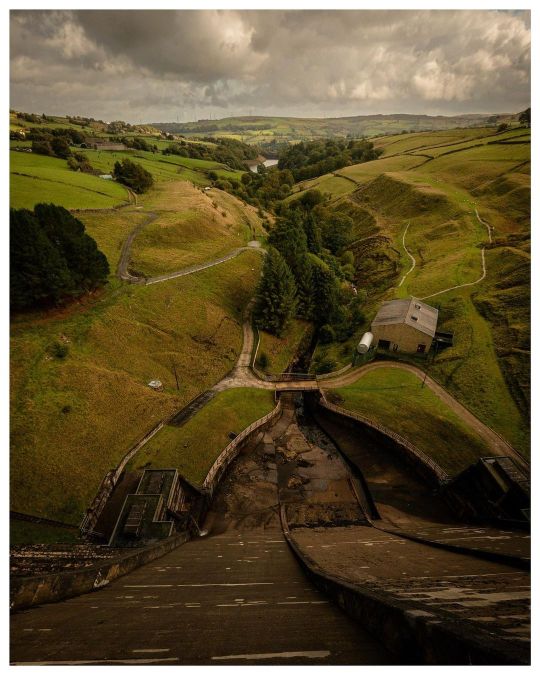
Looking Down. Stopped at my favourite reservoir dam on a circuitous way home. The clouds were plentiful, the light was brighter over Ripponden than the other direction. Autumn seems to have arrived but not quite full force. I love this time of the year even if it does mean dodging the rain showers. #fujixh1 #fujixh1photography #fujifilmxf1024 #calderdale #autumn #yorkshire #yorkshirephotographer #igersyorkshire #natgeo https://www.instagram.com/p/CjYCmn6ISW-/?igshid=NGJjMDIxMWI=
#fujixh1#fujixh1photography#fujifilmxf1024#calderdale#autumn#yorkshire#yorkshirephotographer#igersyorkshire#natgeo
125 notes
·
View notes
Text
News report on the filming of Jenna's next series, The Jetty!
It also says its due to air next year which I guess makes sense but there has yet to be official word on that I think.
6 notes
·
View notes
Text
Monday 12 June 1837
7 ¼
12 20
fine morning rather hazy as if for more rain at 7 ¼ - F57° at 8 and went downstairs sometime talking to Blythe – breakfast at 9 in about ¾ hour – then out – at the meer at 10 – could not see that Robert + 5 (Sam Booth, Jack Green, John Holmes, William Frier, and Michael) had done much – sharpened them up – James Sharpe the mason there squaring the pillar stones at top and bottom for the by-wash covered places 4 men at the run of stuff to make up about the meer-clow house in Charles H-‘s field and occasionally called off to the by wash – took James the mason to straighten up Robert’s cobbling up of the walls on Saturday and kept him ½ hour overtime ill 12 ½ for which gave him 6d. – ½ hour with A- from 1 to 1 ½ and ate 4 oranges – then out again at the meer till rain came on at 5 35 – all took shelter for 20 minutes then the rain continuing went home – had Joseph Mann a few minutes who brought his coal book and paid me for the last few loads got in bringing up the level for Long goit – with Blythe and Booth who had been at the Lodge plumbing the stone gate posts B- having had a note from Mallinson saying that one post was 3/8 in. and the other out of perpendicular and where the posts were right the gates would fit – I told B- I was annoyed at his being in fault – the posts (he said one was plumb) the one post must be made plumb – and the gates being as much in the twist as ever (one an in. the other 1/2in.) they should go back to M- and I should reset the old gate – dressed – dinner at 7 10 to 8 and then came away before having had the finger glasses and slept on the sofa A- brought me coffee about 9 and at 9 ½ had Cookson up to cut my short back hair a great relief – had Holt at the clow-house this morning about (before) 11 with Wood the engineer – who came to say that they had had an order from Mr. Husband to make the wheel strike only five strokes per minute – It had always been ordered to make 11 or 12 str. per minute – W- sure it would not answer to make only 5 – H- sure so too – W- could not tell what to do – H- too wanted ½ the engine pit leaving clear for getting the stuff up – W- obliged to alter the motion – but would take it upon himself and sure he could make it answer – very well! said I – do so – Mr. Harper will be here on the 26th and W- to be sure to be here to meet him – make the wheel to make 12 str. per minute and let H- have ½ the pit clear – much better for my hair cutting – A- sat with me till about 10 ½ while I ate 5 oranges and she one – then wrote all the above of today – and had A- ten minutes she tired her being tired is terrible enough to put anyone in the vapours it was this sent me off after dinner just to get rid of her for tho’ I was sleepy after my dinner and bid her an agreeable companion was all I wanted poor A- this she can never be – finish day about 5 ½ afterwards rainy evening and F58 ½° at 10 ½ pm Holt to be here on Wednesday afternoon and Friday morning and to go on Thursday to choose wood (oak) beyond Ripponden for pit-work – said they had sent for him to Bouldshaw – had holed thro’ east and west board – told them to put in another hole thro’ the east board to go at the back of the buildings and then he would measure off this piece of coal got – Letter post paid tonight from Mr. Brown drawing master York with prospectus of his work dedicated to the archbishop and to be published by subscription – the history of the metropolitan church (minster) of St. Peter York with extracts from the records of the See and Illustrations Frank and Zebedee began carting brick from Swan banks brought 400 each at a time
Mr. James Norris called today and saw A- who positively refused pledging herself respecting the navigation clerk to succeed Mr. (William) Norris
3 notes
·
View notes
Text

Baitings Reservoir in Ripponden, West Yorkshire, in summer 2022, when the total stock of water in England's reservoirs was at its lowest level since 1995. Photograph: Danny Lawson/PA
‘Drought is on the Verge of Becoming the Next Pandemic’
While the world becomes drier, profit and pollution are draining our resources. We have to change our approach
— By Tim Smedley | June 15, 2023
During the summer months in the Oxfordshire town where I live, I go swimming in the nearby 50-metre lido. With my inelegantly slow breaststroke, from time to time I accidentally gulp some of the pool’s opulent, chlorine-clean 5.9m litres of water. Sometimes, I swim while it’s raining, when fewer people brave it, alone in my lane with the strangely comforting feeling of having water above and below me. I stand a bottle of water at the end of the lane, to drink from halfway through my swim. I normally have a shower afterwards, even if I’ve showered that morning. I live a wet, drenched, quenched existence. But, as I discovered, this won’t last. I am living on borrowed time and borrowed water.
Water stolen from nature, drained from rivers and lakes and returned polluted, allows me to live this way. It will have to stop – not through some altruistic hand-wringing desire to do better, but because even in England this amount of water will soon be unavailable. Like many parts of the world, we are now using more water than we can sustainably supply. As surface water and groundwater levels dwindle year by year, a crisis awaits. It’s simple maths. Demand is outstripping supply.
Little old England manages to encompass many global water problems – scarcity, overabstraction, pollution, underinvestment, government and regulatory failings, environmental degradation and corporate misconduct – all within the confines of one small country in the far west of Europe.
The UK’s average annual rainfall is about 1,100mm, compared with less than 300mm in Pakistan or double figures in Egypt. However, despite our winter storms, significant parts of the UK are staring down the barrel of empty water butts. Much of that four-figure rainfall average is propped up by the rainy Highlands of Scotland, Wales and northern England. In south-east England, where I live, the average annual rainfall lingers about 600 mm – comparable with Lebanon or Kenya, and drier than Sydney, Australia. This also happens to be the UK’s most populated area, with about 18 million inhabitants packed into just 19,000 sq km, including London’s 1,500 sq km. And it’s drying up, fast. Government figures show that, in England, 28% of groundwater aquifers, the layers of porous sand and rock that hold water underground, and up to 18% of rivers and reservoirs, have more water taken out than is put back in. This is clearly unsustainable.
Not a single one of England’s rivers is classified as being in good ecological health – this includes chalk streams, a delicate habitat almost entirely unique to England. However, much of the public remains oblivious to a problem that we are all, at least in part, responsible for causing. More than half of the freshwater abstracted in the UK is for household use. The average British resident happily uses 153l of water a day, through showers, toilets, dishwashers, washing machines and garden hoses. Yet climate-change projections show that dry summers in England will increase by up to 50%, with the amount of water available reduced by at least 10-15%.
Freshwater shortages, once considered a local issue, are increasingly a global risk. In every annual risk report since 2012, the World Economic Forum has included water crisis as one of the top-five risks to the global economy. Half of the global population – almost 4 billion people – live in areas with severe water scarcity for at least one month of the year, while half a billion people face severe water scarcity all year round.
There’s only ever the same, finite amount of water churning around in our water cycle. Every drop of water on Earth has been here since the beginning of time, constantly recycled. Up to 60% of the adult human body is water (even bone is a surprisingly splashy 31%). When you die and are cremated or buried, that water will be released again, to the atmosphere or the earth. We are as intimately connected to the water cycle as rivers and lakes are.

Lake Urmia in the North-west Region of Iran, pictured in 2018, has shrunk by 80% over the last 30 years. Photograph: Dominika Zarzycka/NurPhoto via Getty Images
Yet, from the Yellow River in China to the Colorado River in the United States, many rivers no longer reach the sea. Often artificially straightened and dammed, water is sucked out and channelled off to supply farms, industries and households. Great lakes, from the Aral Sea in central Asia to Lake Urmia in Iran, have nearly disappeared. Groundwater aquifers, from the Ogallala and Central Valley in the US to India’s Upper Ganges and Pakistan’s Lower Indus, are being depleted faster than they can refill. The remaining freshwater is increasingly polluted with sewage and fertilisers, causing algal blooms that smother and choke ecosystems.
According to Torgny Holmgren, executive director at the Stockholm International Water Institute, “If these trends continue, we will need 50% more water in 2050 compared with 20 years ago. And, of course, that is impossible, because water is a finite resource … This will impact all of us.”
Covid brought water issues into sharper focus. “It’s not like Covid woke us up to the need for water for hygiene; we already knew that,” Gary White, CEO of Water.org, told me. “But I certainly think we hadn’t seen the lack of access to water and sanitation as a global crisis before. When somebody [being unable to] wash their hands in one country becomes the critical link to the spread of disease, then suddenly water and hygiene becomes a global risk.” In June 2021, Mami Mizutori, the UN secretary general’s special representative for disaster risk reduction, said: “Drought is on the verge of becoming the next pandemic, and there is no vaccine to cure it.”
The good and bad news is that water crises are usually caused by human mismanagement, not climate. But, as climate breakdown bites, precipitation patterns change and climate refugees are forced to move, the timeframe to get our act together is becoming ever shorter. We are currently using up the water sources on which our very existence relies. We can continue doing that until the very last drop. Or we can decide to change our approach before it’s too late. The world isn’t running out of water – people are.
The UK’s Waterwise annual conference in 2019 was a niche water efficiency conference in London, attended by a small cadre of water industry types. But it made national news. Sir James Bevan, then chief executive of the Environment Agency, had heavily altered the prepared speech he had been given. An expected tame welcoming address instead became known as the “Jaws of Death” speech. As his audience shifted uncomfortably in their seats and a handful of trade journalists suddenly woke up, he said: “The jaws of death is the point at which, unless we take action to change things, we will not have enough water to supply our needs … many parts of our country will face significant water deficits by 2050.”
The water-abstraction system his agency oversees was “designed more than 50 years ago, for a world with less environmental protection, less demand for water and no awareness of climate change”. Just as important as new infrastructure was changing human behaviour: “We need water wastage to be as socially unacceptable as blowing smoke in the face of a baby.” The industry audience didn’t know whether to whoop or weep.
On 9 July 2020, the public accounts committee countered that all the bodies responsible for the UK’s water supply – the Department for Environment, Food and Rural Affairs (Defra), the Water Services Regulation Authority (Ofwat) and Bevan’s Environment Agency (EA) – had “taken their eye off the ball” and must take urgent action to ensure a reliable water supply. The committee’s chair, Meg Hillier MP, said: “It is very hard to imagine, in this country, turning on the tap and not having enough clean, drinkable water come out – but that is exactly what we now face … Defra has failed to lead and water companies have failed to act.”
Without significant action, the National Audit Office (NAO) forecasts that the total water demand will start to exceed supply in England no later than 2034. However, water companies have already been abstracting (extracting) too much water, leading to environmental degradation and the disappearance of rivers, including the internationally unique chalk streams of the south-east. A reduction of 480m litres a day is needed by 2045 just to lower existing groundwater abstraction to sustainable levels. Something, or someone, has to give, or the UK’s water supply will run out within a decade.
Part of England’s problem goes back to its unique system of private water companies being handed state monopolies. Prior to 1989, water supply was publicly owned, like it is everywhere else in the world. But Margaret Thatcher put a stop to that. In 1989, the 10 water authorities spanning England and Wales had their assets and personnel transferred into limited companies and floated on the London Stock Exchange. Today, almost everyone in England and Wales receives their water and sewerage services from the same 11 water and sewerage companies and six water-only companies (with some specific areas served by small limited companies). Each has its own fiefdom on the map, with no competition, run for private profit; you are obliged to sign up to your regional supplier.
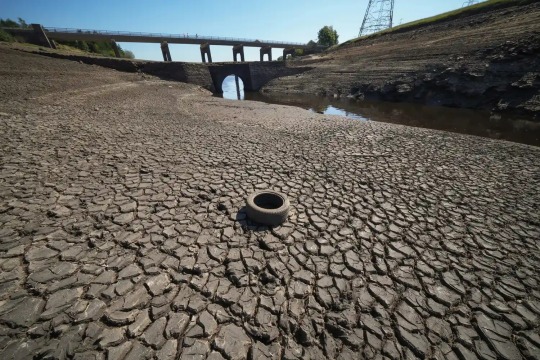
An Ancient Packhorse Bridge is revealed at Baitings reservoir in the West Yorkshire Pennines, 2022. Photograph: Christopher Furlong/Getty Images
The Water Act 1989 also removed previous restrictions on the statutory financial amounts water companies could borrow or pay as dividends. To protect the interests of customers and the environment, however, privatisation was coupled with regulatory oversight, most notably from the EA, the Drinking Water Inspectorate and Ofwat. Because of the lack of competition, Ofwat sets limits on the price water companies in England and Wales can charge. And, to ensure that those companies don’t just snaffle the cash and let the infrastructure they inherited fall to ruin, every five years the water companies must also submit statutory water-resources management plans setting out their intended investment approach for the next 25 years. Despite this, a fair amount of cash-snaffling still goes on. A 2017 study by the University of Greenwich found that water-company shareholders had received a total of £56bn since privatisation, with some water CEOs on £2m annual salaries.
By 2018, the then leader of the opposition, Jeremy Corbyn, was calling for the water companies to be renationalised. Even the incumbent secretary of state for Defra, Conservative MP Michael Gove, attacked the water companies for “playing the system for the benefit of wealthy managers and owners, at the expense of consumers and the environment”, and suggested that they had “shielded themselves from scrutiny, hidden behind complex financial structures, avoided paying taxes, have rewarded the already well-off, kept charges higher than they needed to be and allowed leaks, pollution and other failures to persist for far too long”. In cash terms, more than £18.1bn was paid out to shareholders of the nine largest water companies between 2007 and 2016, accounting for 95% of profits.
Australian infrastructure firm Macquarie owned Thames Water between 2007 and 2017, leaving it with £2bn of debt, while paying its investors, according to one analysis, on average between 15.5% and 19% in dividends a year. Instead of making changes to a system that was supporting such poor levels of investment, in August 2021, Ofwat approved a new £1bn equity takeover of Southern Water. The new owner was Macquarie.
Unlike the relatively high rainfall of Wales, Scotland and Northern Ireland, England’s water situation is surprisingly perilous. London only has 90 days of water storage at any one time. A water industry insider told me that in 2012, shortly before the Olympics, the capital came within days of exceeding that tally. If it had, Thames Water would have been forced to cut supply to households and install public standpipes. That situation – dubbed “Day Zero” when Cape Town, South Africa, faced the same predicament in 2018 – remains a serious possibility.
Andrew Tucker, water efficiency manager at Thames Water, tells me bluntly that, in London and the south-east, “we basically don’t have enough product, going forward. Ultimately, we will need to bring new water supply into the system … All water companies in the UK rely on winter rainfall to recharge these systems … If we don’t get that winter recharge, it just drops and keeps on dropping, because our raw water storage [reservoirs] is actually quite small.”
Tucker is Australian and says mates back home find it funny that England can have a water problem, given its wet reputation. “We do get a lot of grey days. But grey doesn’t mean rain. Even drizzle doesn’t mean rain.” He gives me a quiz question: “Which Australian state capital city gets more rain on average every year than London?” I guess Sydney. “They all do.”
There are several reasons for England’s comparative lack of water storage, Tucker says. First, “every square inch of land has been used pretty intensively for the last thousand years and there’s not much room to play with”. Second, the south-east is relatively flat, with no valleys to dam. Third, we have a population poorly educated in the need for water saving or living with drought. And water is too cheap – or at least not valued. When we speak, Thames Water’s combined water supply and wastewater charge is about £2.20 per 1,000l. “You pay the same for one litre of water at WH Smith at the train station,” he says.

Tree skeletons at Colliford Lake Near Bodmin, Cornwall, 2022. Photograph: Matt Cardy/Getty Images
Tucker argues that education and cultural awareness are even greater drivers of water efficiency than price, though. He says they are trying to advocate the introduction of water-use restrictions, like in Australia, so “it becomes a cultural thing”. He notes that, in England, companies are “crucified in the media” for suggesting ways the public can reduce seasonal demand. When I suggest that, after months of heavy winter rain, the public perception is, “Well, why wasn’t that banked somewhere?”, he quickly interjects: “There is no bank. We want a bank. We’ve been prevented from getting a bank for 20 years.”
Thames Water estimates that by 2045, it will need to find an extra 350m litres of water supply a day. The “bank” that they’ve wanted for 20 years is the long-planned but never built Abingdon reservoir. First proposed by Thames Water in 2006, it would be the largest major reservoir built in southern England since Rutland Water in 1976, and capable of supplying their entire shortfall with one big project.
The problem is, as Tucker identified, the region has no valleys to flood. The site near Abingdon, Oxfordshire, is perfectly flat, fertile farmland. The only way to build is up – what’s known as a “bunded reservoir” – and Thames Water wants a 150bn-litre capacity, which could take nine years to build, according to local campaigners, covering more than 6sq km of land, with built-up banks 30 metres high – making it the largest bunded reservoir in the world. This wouldn’t just be a blot on the landscape, it would be the landscape.
A public inquiry in 2010 produced a 326-page report concluding that the Abingdon reservoir proposal did not meet the statutory requirements and that a reservoir of that size was not justified by the evidence. That didn’t stop Thames Water from putting it – with minor tweaks and changes – into every five-year management plan since. Now rebranded the South East Strategic Reservoir Option, as a joint proposal between Thames Water and Affinity Water (supplier of drinking water to the south-east, owned by various fund managers), it looks likely to finally go ahead.
England does need more water storage – and London’s 90-day supply is clearly untenable with dry summers set to increase. But does it need a giant sledge-hammer solution to land in rural Oxfordshire? Or, as local campaigners the Group Against Reservoir Development argue, are there myriad other, less damaging, options on the table? One of which is the storage beneath our feet.
Regenerative agriculture, a system that works without ploughing, has begun to attract attention in places as far-flung as the US, Australia and the UK. The idea of the “no-till” method is to prevent soil disturbance at all costs. Tilling (another term for ploughing) is “like a tornado coming through an ecosystem”, explains Evan Wiig, a former rancher who now promotes regenerative farming for the Community Alliance With Family Farmers. The plough destroys the connections between “the fungi, the nematodes, the earthworms, all of that subterranean ecosystem. The more you can keep that intact, the better water-holding capacity you have.” Healthy soil is a sponge of crisscrossing roots, wormholes and mycorrhizal fungi, all of which retains moisture, maintains nutrients and captures carbon. You also find healthy, recharged aquifers beneath.
Unlike in the western US, where artificial irrigation is necessary, farming in the UK is almost entirely rainfed. But the rains are becoming less and less reliable. James Alexander’s family has been farming in Oxfordshire for generations. “There’s no seasons any more,” he said. “For the last three years, we’ve just had wet and dry. It does get a little colder in the winter, but not like it used to … the last two winters have been two of the wettest on record, but actually that rain’s only fallen in about six weeks.”
It was May when I visited in 2021, and he asked, rhetorically: “Remember April showers? We only had 2mm of rain last month.” That’s why he now prefers no-till farming. He described conventionally ploughed fields as containing “sad soil”, simply a dead growing medium to hold the plants upright; many litres of pesticide and fertiliser need to be sprayed to grow anything in it. The topsoil also compacts under the constant heavy machinery, forming a hard cap layer, causing nearby roads to turn into muddy streams with each significant rainfall.
Out on the no-till field, meanwhile, his boots never get muddy. The soil forms an intricate sponge that soaks up water, both delivering it down to the groundwater and maintaining moisture for the crops. The undisturbed mycelial fungal network has been found to supply 80% of a crop’s nitrogen requirements and up to 100% of its phosphorus requirements, and to provide water to crops in times of drought.
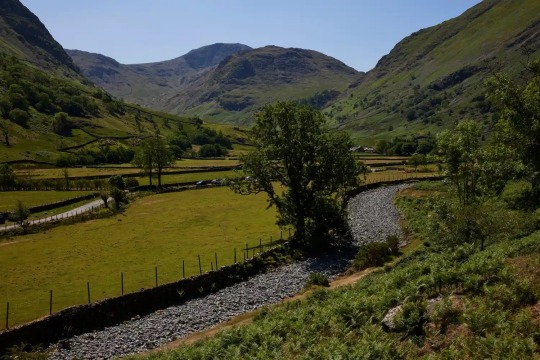
The River Derwent in Cumbria has run dry in parts of the Borrowdale valley for the third consecutive year. Photograph: Christopher Thomond/The Guardian
We gain underground water storage too. And not just a marginal gain. Water supply, and water storage, all comes down to capturing rainfall – and there is no greater surface area in England than farmland. Jake Rigg, then director of corporate affairs and communities at Affinity Water, in the east of England, told me he had asked an agricultural research institute to establish how much more water can go to the natural underground aquifer using no-till techniques. “And they said, ‘You’re talking about having an Abingdon reservoir-sized amount of extra water in the aquifer’.” Such a volume would, in effect, solve England’s water-scarcity problem. Without, by the way, having to build the Abingdon reservoir.
On England’s south coast, Southern Water are now paying farmers to leave crops on their fields over winter, rather than bare, tilled earth – financially incentivising no-till farming. This is not only for the groundwater-recharge benefits, but also to reduce nitrates from conventional farming leaching into the groundwater and rivers. Robin Kelly, catchment risk management officer at Southern Water, told me that “nitrate concentrations in many of our groundwater sources are high and rising, and it is this trend we are focusing on and trying to reverse. The results clearly show a benefit of having continuous green cover over the winter.” In the first year of the scheme, farmers near Brighton were offered £35 per hectare of overwinter cover crops. In some regions, this has since increased to £109/ha. The simple calculation is that it’s more expensive for water companies to treat the water than it is to pay the farmers not to pollute it in the first place.
We can all do our bit to capture the rain. While the average Briton uses more than 150l a day, performance artist Chloe Whipple spent a year living on just 15l of mains water a day. Key to her success – which began via a project matching local artists with scientists, and paired her with Exeter University’s water expert Dr Peter Melville-Shreeve – was rainwater. A small grant helped her to get a 200l rainwater butt plumbed into her toilet. Collected rainwater was counted as free to use. And it changed her relationship with the rain for ever.
Despite living on the relatively dry south coast, “there is so much rainfall,” Whipple says. “I mean, obviously, there’s more and more dry periods now. But there’s so much that we could be harvesting and storing.” You might think, then, that Whipple’s message would be that everyone should do more to reduce their personal water use. It is partly that. But her main message is quite different. “I feel like, a lot of the time, the onus is on us as individuals to completely change our behaviour, and buy all the stuff we need to be self-sufficient – that it’s our sole responsibility … When really it’s a much bigger picture.”
Melville-Shreeve has tried to engage housing developers and water companies with large-scale rollouts of domestic rainwater capture, only to be frustrated; Whipple, too, sees a lack of engagement from the very authorities tasked with averting the coming water crisis. “There’s just literally no one making decisions for the long term, it’s so shortsighted,” she says.
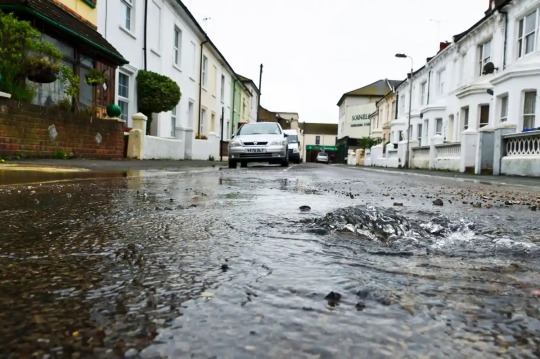
A water leak in the middle of a residential road caused by a burst water main. Photograph: JEP Worthing/Alamy
The waste that happens in our water systems, the pollution of our rivers, the leakages in the underground pipes, the building codes that allow developers to build water- inefficient houses: all that happens before we even turn a tap on. The wastage, the 150l a day, is built into the system. There is a lot we can do as individuals, but those things almost all boil down to water-efficient appliances, rainwater capture and greywater recycling, all of which could and should be integral to water company practices and building regulations. In Belgium, for example, you don’t consider installing a rainwater-capture tank in a newbuild home – you have to.
Should we all be showering with buckets by our feet to capture the water and reuse? It’s not a bad idea. In parts of the world that have experienced water rationing, such as Cape Town, and mining towns in Australia, it remains a common practice – once you’ve lived it, the lessons tend to stick. But the bigger wins are to be found in changing water company practices through regulation, and incentivising new farming practices through education and compensation: Defra’s environmental land-management services payments can incentivise regenerative and cover-crop farming methods, and compensate for the restoration of floodplains. This should include beaver reintroductions, which have been found to regenerate and restore rivers and wetlands.
We canalised our rivers, drained our land, overpumped our groundwater, dried our wetlands, burned our peat, killed off our keystone species, all in the belief that modern engineering had decoupled us from our dependence on the natural system. It was always hubris. The climate crisis hasn’t caused the water crisis we now face, it has simply shone a punishing, unyielding light on it. The answers, from Abingdon to Accra to Amman, lie in holding on to the rain that falls on the land. And nature does this best of all. Now our engineered systems must work with nature, not against it.
— This is an Edited Extract from The Last Drop: Solving the World’s Water Crisis, Published by Picador
0 notes
Text
UK heat wave | An ancient bridge reappears in a nearly dried up reservoir
UK heat wave | An ancient bridge reappears in a nearly dried up reservoir
Sorry, your browser does not support videos
After the heatwave hit the UK, an ancient bridge has reappeared in the nearly dried up Baitings Reservoir near Ripponden, West Yorkshire (northern England).
window.fbLoaded = false;
window.fbAsyncInit = function() {
FB.init({appId: ‘166995983353903’, version: ‘v3.2’});
window.fbLoaded = true;
};
(function() {
var e = document.createElement(‘script’);…
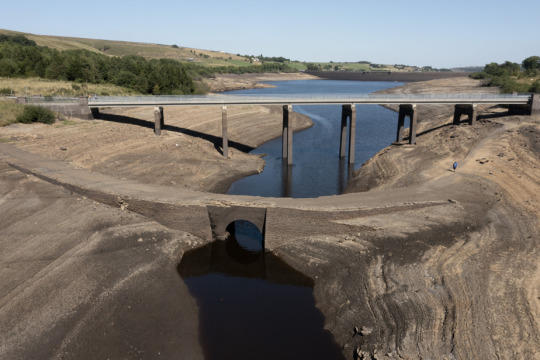
View On WordPress
0 notes
Text
1835 March Friday 13 part 2
off with Adney at 3 1/2 to Cliff hill – walked with her to the Crownest paddock site[?], and then returned to speak to Holt who was with the 2 Manns measuring the length of drift there would be from Mytholm dam-stones to Coffin Lane bridge end – drift 240 yards long – would get out of the wood about midway between Breakneck cottage Coffin Lane bridge – would be 5 yards drop below the surface of the wood – would want a vent hole every 40 yards the last to be always filled up as soon as another made – Told him to settle about price and get it begu?n as soon as possible to work shifts – i.e. night and day – anxious for the Pump pit to be set a going as a sale pit as soon as possible – Holt thinks it will take at least a 12month – the Tilleyholme vent-pit to be let alone till the drift is driven up to it, for this will take the water off it which we have been fighting with – the pit sinking was agreed for at 6/. per yard but on account of having so much water must mend[?] the price – not agreed how much – this pit is 9 yards 2 feet deep and is at the upper bed which is whole coal – the youngest Machan will be of age on monday – He will come to Shibden on that day and bring me plans from 3 wheelwrights of a water wheel – from Shay of Ovenden, and Bates of Ripponden, and Bates of Sowerby bridge – to talk over Mrs Machan’s coal on monday – said I should be glad to have it – but it seemed to me not quite so necessary as I thought it at first – to which H- (Holt) seemed to agree – said Mr Rawson could not get much of it – for George Naylor’s fields extended too far - I said I thought Rawson could not get more than 25 acre of Sammy Hall’s coal, to which Holt quite agreed – mentioned to him Walsh’s share in the coal of the waste – he said Walsh had spoken to him about it but he Holt had forgot to tell me – Walsh wants to sell – Hinscliffe got £60 for his share from Mr Rawson Holt thinks he can buy Walsh’s for me for £30 – told him to make the bargin for me, if he could, at this price – then off again at 5 1/4 for Adney dawdled about the Cliff hill land till went into the house at 5 3/4 and sat 1/2 hour – home at 7 A had told her aunt all about her sisters making over the property to captain S and about her own As will and heard about her aunts the long and the short as she thought A had left all she had to me and so she Mrs A W had the next thing to cut A out for it neither she nor Mrs Sutherland to be executors but Mr W Priestley A pleased by saying she had left all to Sackville nothing yet settled about me but if A did not marry should probably stay with me and we should mutually give each other a life estate in all we could dinner at 7 1/4 coffee – wrote the last 45 lines – 1/2 hour with my aunt till 10 1/4 p.m. at which hour F 46°. very fine day –
0 notes
Photo

Post Office, Ripponden Road, Oldham
0 notes
Photo
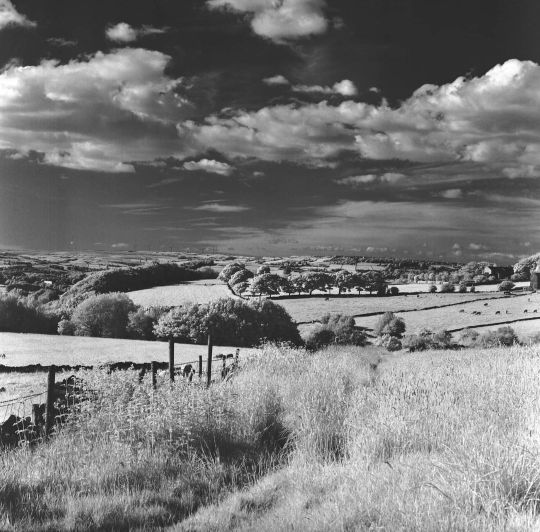
Local #rollei #rolleiinfrared #rolleiinfrared400 #rolleiir400 #infrared #infraredphotography #infrared400 #r72 #r72filter #ripponden #westyorkshire https://www.instagram.com/p/CR9bYXsoe3K/?utm_medium=tumblr
#rollei#rolleiinfrared#rolleiinfrared400#rolleiir400#infrared#infraredphotography#infrared400#r72#r72filter#ripponden#westyorkshire
11 notes
·
View notes
Photo
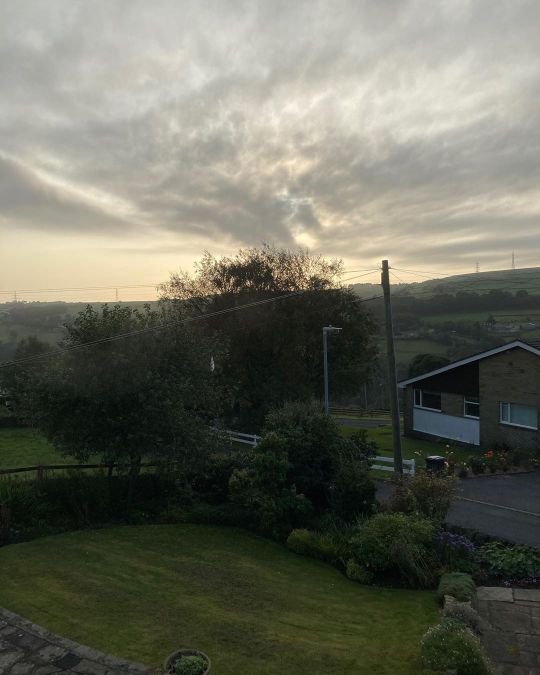
Last Bloody Tango in Halifax #views #upnorth #landscapephotography #moodysky #sunrise #ripponden # https://www.instagram.com/p/CFOs25WlrsK/?igshid=gy7z1n0c588
0 notes
Video
Last years leaf by Ruth
Via Flickr:
Ryburn Reservoir One of a handful of dead leaves still clinging to a tree. No idea what it is. Thank you for your visit and your comments, they are greatly appreciated.
#Nikon#Nikon D3200#Tamron 16-300mm#UK#Outdoor#Yorkshire#Ryburn Reservoir#Ripponden#Leaf#Dead Leaf#Tree#Bush#Twig#Nature#Brown#DOF#Explored#Explore#In Explore#Macro
12 notes
·
View notes
Text
0 notes
Photo
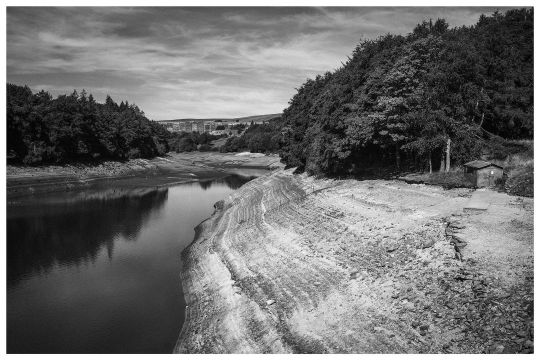
Drought. Ryburn reservoir above Ripponden. Alarmingly low levels seen at this and many other reservoirs around the country. It’s great for those of us who love taking images that highlight the textures and shapes of land but we need to conserve water right now. #fujifilmxt2 #fujixt2 #ttartisans50mm12 #bnw #bnwphotography #bnwlandscapephotography #yorkshire #yorkshirephotographer #igersyorkshire #myfujifilm #myfujilove #natgeo #westyorkshire #landscapephotography https://www.instagram.com/p/ChGAxrpIUs5/?igshid=NGJjMDIxMWI=
#fujifilmxt2#fujixt2#ttartisans50mm12#bnw#bnwphotography#bnwlandscapephotography#yorkshire#yorkshirephotographer#igersyorkshire#myfujifilm#myfujilove#natgeo#westyorkshire#landscapephotography
2 notes
·
View notes
Text
Pickles, Wills and Angry Anne
Mon[day] 30 March 1835
7.5
11.20
No kiss Fine morn[in]g F 44° at 8 a.m. Settling acc[oun]ts till 9, sat w[i]th A-[Ann] in the bl[ue] room whi[le] she w[a]s at her
draw[in]g. Br[eak[f[a]st at 9.5. H[a]d W[illia]m Keighley for a min[ute] or 2 and p[ai]d h[i]m his bill for fell[in]g etc in full
up to t[hi]s ti[me]. St[oo]d d[o]wn st[air]s talk[in]g of Tom in Switz[erlan]d dur[in]g the summ[e]r, till 10 1/4 t[he]n 1/4 h[ou]r in my study
V look[in]g at mag[azine]s, t[h]en h[a]d Washington a few min[ute]s. The own[e]r of the Traveller’s Inn asks £200
for the licence or £1000 for licence and the who[le] pile of build[in]gs. T[he]re are 7 cott[age]s, the Inn w[oul]d ma[ke]
5 mo[nths] and t[he]n 12 easy rent[e]d w[oul]d let for £48 p[e]r ann[um]. S[ai]d I th[ou]ght t[hi]s too d[ea]r, h[a]d giv[e]n up the th[ou]ght
V of buy[in]g the licence hav[in]g let the Mytholm land. H[a]d Mr Bradley at 10 3/4, the N[orth]g[a]te plan w[i]thin
a day of being finish[e]d, to ha[ve] it on Sat[urday]. Talk[e]d all t[hi]s ov[e]r and ab[ou]t T [Thomas] Greenwoods purchase in N[orth]g[a]te
and all ab[ou]t the engine pit, wat[e]r
wheel and tail-goit. Took Mr B-[Bradley] out ab[ou]t 12, look[e]d ov[e]r the site of intend[e]d dam and the who[le]
line of goit etc etc. Look[e]d ab[ou]t at Mytholm, the old arch ov[e]r the brook will do for the
Chase in Trough of Bolland. £6 will cart and set it up t[he]re, will £10 do it s[ai]d I?
Ab[ou]t 2 1/4 h[a]d Pickells to rec[eive] orders ab[ou]t the dry bridge, he ought to ha[ve] been wall[in]g in
Mytholm h[ou]se gard[e]n. H[a]d din[e]d at the Stag’s Head and w[a]s fresh [drunk] when he ca[me] to Mr B-[Bradley] and me.
I took no not[i]ce of t[hi]s to him P-[Pickells] at the ti[me] b[u]t made the best I c[oul]d of it to Mr B-[Bradley] who
ca[me] in at 3 and h[a]d a cold veal din[ner] and w[e]nt away at 3 1/2, he w[a]s to go to Ripponden
to consult Mr Holroyde ab[ou]t the best engineer, or if t[he]re be a good one in Manchester.
Mr B-[Bradley] if satisfi[e]d, to tell the engineer to co[me] ov[e]r here and gi[ve] me a plan for the water wheel and
V- Visit
1835
M[ar]ch
goits, and t[he]n Mr B-[Bradley] will see the plan prop[erl]y execut[e]d 20 min[ute]s w[i]th my fath[e]r till 3.50 t[he]n stood talk[in]g to
Ch[arle]s How[ar]th in the
workshop ab[ou]t an h[ou]r till 5, s[ai]d how annoy[e]d I w[a]s at P-[Pickells]. Ch[arle]s s[ai]d wh[a]t he coul]d to excuse h[i]m
b[u]t saw I w[a]s n[o]t pleas[e]d. Off at 5 and at Cliffhill in 35 min[ute]s to meet A-[Ann], sat t[he]re w[i]th h[e]r and
h[e]r a[un]t 3/4 h[ou]r till 6.20, walk[e]d leisure[l]y and ho[me] at 7.20. A[Ann] had long talk with her aunt who
has left cross and latts farm to sacville and Mr Willam priestley sole executor, furniture
plate linen and china were first left to A[Ann] now to her sister but as A[Ann] has not given all she
has to me her aunt may change back again in her favour she told how I had erased
Mr W. [William] P. [Priestley] from being my executor on com[in]g in Geo[rge] told me my fath[e]r h[a]d fallen ab[ou]t
an h[ou]r in the low court. W[e]nt in to h[i]m, n[o]t at all hurt, n[o]t giddy, b[u]t fell fr[om] weakn[e]ss.
Din[ner] at 7.40, coff[ee], ca[me] upst[ai]rs at 9 just as my fath[e]r w[a]s go[in]g to bed. Till 9 1/2 wr[ote]
all b[u]t the 2 first lines of today. As I came in at 6.20 Pickells here wait[in]g for an
ans[we]r ab[ou]t rag covers, just told h[i]m I w[oul]d say noth[in]g to h[i]m tonight. I w[a]s too m[u]ch vex[e]d
and walk[e]d off. W[i]th my a[un]t fr[om 9 3/4 to 10.10 at w[hi]ch h[ou]r F47 1/2° fine day.
3 notes
·
View notes
Text
Thursday 30 March 1837
8
11 40
no kiss I see A-‘s irritability is returning but she behaves as well as she can poor thing we must be off as soon as we can – fine sunny morning F57° in the sun but I feel very cold – as if it was a hardfrost - breakfast at 9 ½ having seen Mr. Horner while he was with A- - he mentioned the mechanics Institute – but on my asking if I was to consider what he said as official he answered no! but it was said he was in the habit of coming here and therefore they wished him to inquire if I should object to let them have ground – I said I would consider about it – I was anxious for the spread of genuine knowledge but would not inflict upon the town a building in bad architectural taste – I should wish to see and be satisfied with the plan of any building before its being built on my ground – I did not always admire the taste of committees – I would consider the thing – asked what was wanted – a library, museum school room reading rooms chemical laboratories thought of 20x15 yards for the site – I asked him to give me a sketch of his own idea of what he himself should like – and I would tell him what I thought – I mentioned the building at Keighley as a faulty piece of architectural taste – he did not seem aware of its making £43 per annum – he mentioned wanting a chemical laboratory under the building – that I said would not be wise – it would put them at the mercy of any tyro to blow them up or not – he wanted the lecture-room to hold 600 people! said they had 2000 books – those I said would be easily placed – breakfast at 9 ½ , sat till near 12 thinking over and sketching in pencil a rough idea of a building according to the wishes rather perhaps than to the means of the Institution – but Mr. Horner said they had observed that they should be obliged to have a handsome building if it was near the hotel the building in progress at Bradford it is supposed will be done for £2000 – with A- from about 12 to 12 ½ - then had the little mahogany chiffonier I got for my aunt brought up out of the drawing into the blue room and arranging my books (the small and well bound) in it till about 1 ¼ then went down to Robert Mann who came about the thorns moving that they have just stubbed in the old remains of hedge-rows – long talk about the rag-water and getting water to the engine till Mr. Samuel Bates came about 2 and brought his fathers’ (Mr. George Bates of Sowerby bridge) plans of the Liserwick mill corn-grinding machinery but no estimate with them – they did the wheel of the Miss Walker of Walerclough – 40ft. diameter and 6ft. of breast – they had bad tenants (Mr. Sowden) who did not keep the grates clean – let pieces of wood get in, and break the buckets and did not oil the wheel properly – Mr. Edwards of Pynest has a mill at Ripponden water wheel (under Mr. Wheelwright) 25ft. diameter 6ft. breast – wished me to ride over to see a new corn-mill at Hebden bridge – 6 per stone (Listerwick to have 5 per at 3 horse power per pair = 15 horse power) – water wheel 42ft. diameter and 6ft. breast – Mr. Henry Priestley going to build a mill in [?] valley 60ft. of fall at 18/. per ft. = £54 per annum and a Mr. Hinscliffe had bid £100 then £200 and lastly £300 for the [far] simple of it – Mr. HP- had had Messrs. Bates to level and value for him – annoyed at the lowness of the offer – his steward John Mande of Sowerby bridge advised his building – but was worse again on Friday – not expected to live from day to day – quite out of his head – his own man servant told SB- that it was sure to be true it was near 3 before he went away – then wrote all the above of today till 3 ¼ - then out – Ingham and his boy at the hay-place (opening into the farm and adjoining the new necessaries) wall – saw Sam Booth come up with his right ear covered with blood – stubbed between the old hedge Pearson Ing and round Ing and Michael had struck him accidentally with a mattock – sent John Booth with Sam to the Dispensary – then with Robert + 3 exclusive of Sam – then with Joseph Mann – wants me to let the dead water (upper bed dead water) off near where they are pulling up Long goit stuff within a few yards of the engine pit – then to John Oates’s – stood talking to John O- a very long time till after 6 – Joseph Mann will begin taking the sod off tomorrow for sinking Listerwick tomorrow – told John I should take the whole of that piece – he made no objection – I said took it then as settled yes! – I said nothing more – no allowance was named – he would know I should not forget his paying £60 instead of £70 for the farm – he said I ought to have another shuttle to let the Spiggs water come into the meer at the bottom –asked him to think this over and tell me how he thought it should be managed – he said the meer-banks had sunk 3ft. – too low now – the by-wash at the low end too low – the water would be over or very near the top of the present banks – home at 6 ½ ready in 10 minutes – dinner at 7 – tea – wrote the last 11 ½ lines till 9 50 F29° at 9 ¾ a few snow showers during the day till between 2 and 3 pm afterwards [?]
3 notes
·
View notes